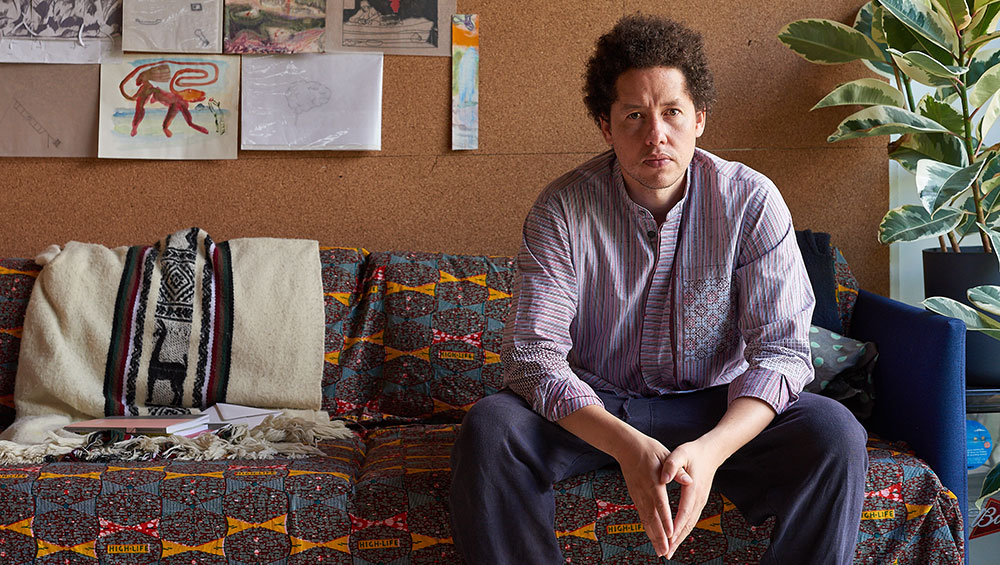
Michael Armitage, 2020. Photo: © White Cube (Theo Christelis).
by JULIET RIX
Michael Armitage (b1984) divides his time between Nairobi and London. Born and brought up in Kenya, he studied art in the UK, at the Slade School of Fine Art and the Royal Academy Schools. His mother is Kikuyu, his father a Yorkshireman, and Armitage’s work spans his dual heritage, incorporating the artistic legacies of both western Europe and East Africa – though he makes both very much his own.
His large scale, highly coloured, multilayered, paintings mix the figurative and abstract, spiritual and political, mythical and historical, in a kind of visual equivalent of literature’s magical realism.
There is plenty of interest in his work. He has had five solo exhibitions in the last four years, ranging from Germany to South Africa, London to Australia, and in 2020 he was awarded the Ruth Baumgarte Award for figurative artists.
Armitage roots his work in his native land by painting not on canvas, but on lubugo bark cloth, an uneven natural material derived from the Mutuba tree [Ficus natalensis] and associated with ritual and ceremony. Western art history is also very present, however, with regular references to the work of masters such as Titian, Goya and Gaugin.
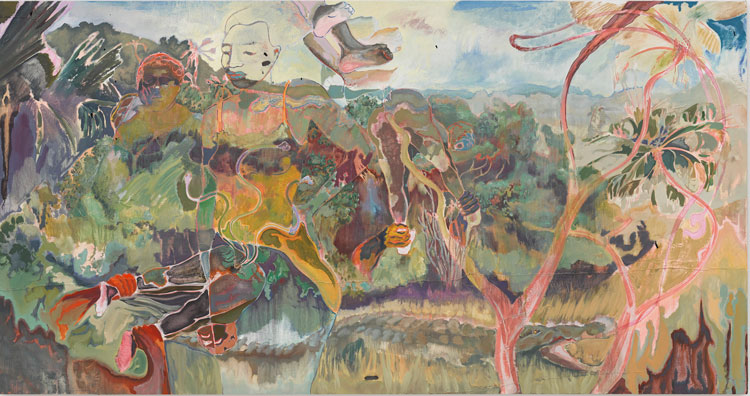
Michael Armitage, The Paradise Edict, 2019. Oil on Lubugo bark cloth, 220 x 420 cm. The Joyner/Giuffrida Collection © Michael Armitage. Photo: © White Cube (Theo Christelis).
In his current show at the Royal Academy, Paradise Edict, there is an exhibition-within-an exhibition, Mwili, Akili Na Roho(Body, Mind and Spirit) displaying 31 works by six East African artists who have influenced Armitage, including Meek Gichugu, Jak Katarikawe, Asaph Ng’ethe Macua and Sane Wadu. Keen to draw attention to, support and connect East African artists, Armitage recently launched the Nairobi Contemporary Art Institute, (NCAI) a not-for-profit art space in the Kenyan capital.
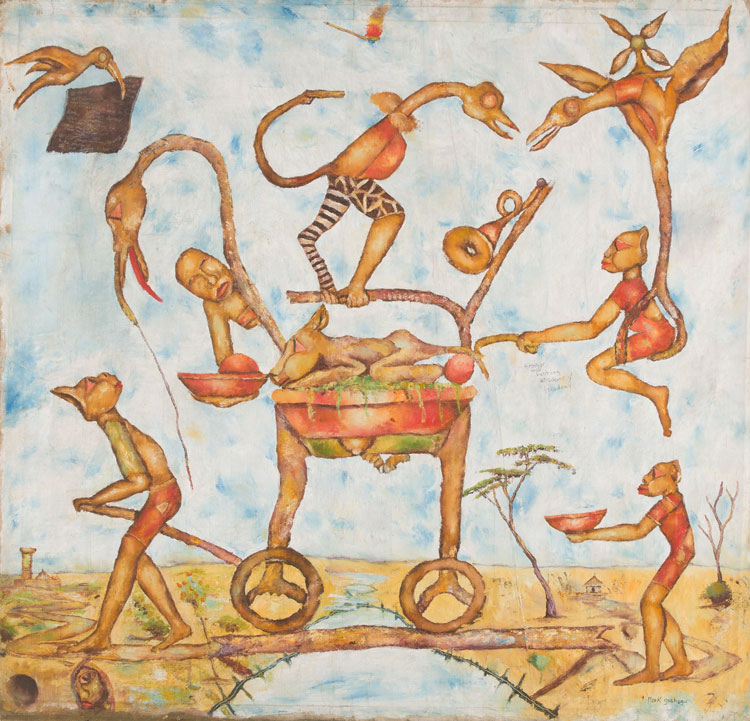
Meek Gichugu, Untitled (Brother Wise Hooking Wisdom & Freedom), c.1992. Oil on canvas, 126 x 132.5 cm. Banana Hill Art Gallery © The artist. Photo: Maximilian Geuter.
Fifteen of Armitage’s large-scale works from the past seven years feature at the RA. Centre stage is the painting that gives the show its name. The Paradise Edict presents us with a lush, exotic, archetypal African paradise, subverted by a range of more or less disturbing images. It arose, Armitage has said, out of hearing a speaker at a political rally in Kenya’s volatile 2017 general election repeating to the crowd that, if they voted for him: “I will lead you to Canaan, the promised land.”
Armitage spoke to Studio International by phone from his London studio.
Juliet Rix: We were originally planning to do this interview face-to-face shortly after the Whitechapel Gallery group show Radical Figures opened, in spring 2020. We all know what happened next, so how has the pandemic period and the lockdowns been for you?
Michael Armitage: It’s been extremely busy. From the perspective of having studio time and making work, it’s been fantastic, having some quiet time that is relatively uninterrupted and not travelling a lot. For quite a while, at the beginning, I was just working on the kitchen table but, once I was able to get to the studio, it all felt a lot more manageable.
Working on exhibitions has been challenging, but I really have to take my hat off to the teams I’ve been working with. They have managed at a time when loans and moving things around has been very difficult, to bring relatively complicated shows together. They’ve done it in different parts of the world, including in Nairobi under curfew, collecting the work for the Mwili, Akili Na Roho room in the RA exhibition.
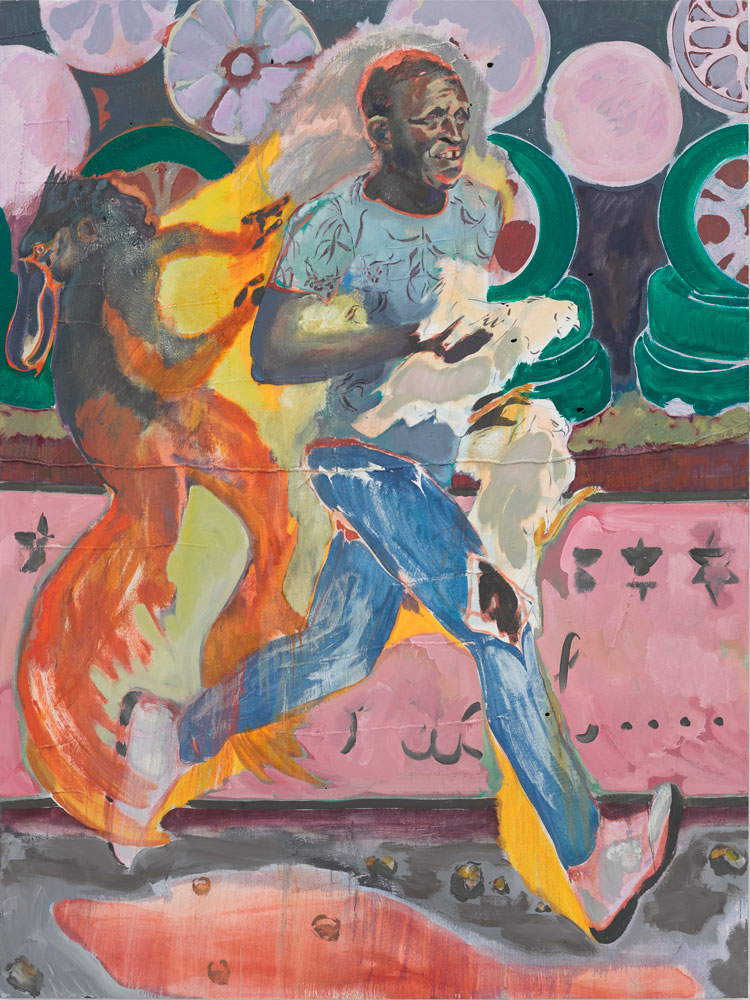
Michael Armitage, The Chicken Thief, 2019. Oil on Lubugo bark cloth, 200 x 150 cm. Courtesy of the Artist and White Cube © Michael Armitage. Photo: © White Cube (Theo Christelis).
We were supposed to open our space at the NCAI for the first time in spring last year. We weren’t able to do that, and had to really think about how somewhere that calls itself an art institute and wants to serve the community and local artists could do that. With the difficulties have come opportunities, though. We’ve done things we would not have had the time or resources to do with our very small team if the space had been open, like a series of Wikipedia editathons – editing artists’ pages, and making pages for institutions that have had no presence, making sure they are well represented. Wiki is often the first point of contact, you Google and if nothing comes up …
We also did an online version of The Gathering that we did in person in 2017 [a three-day event that brought together artists from across the African continent]. From a conversational point of view, it was probably better online than it was in person, although from the point of view of building relationships it is harder online.
And we’ve been working on a series of 18 films on 18 artists, including those in the RA exhibition.
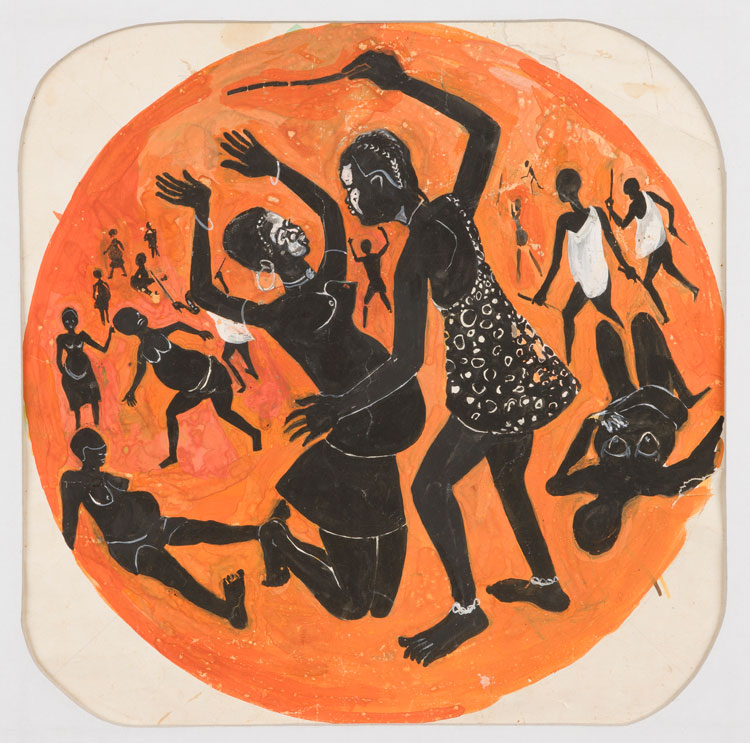
Asaph Ng’ethe Macua, When the Men Took Power From Women, n.d. Gouache on paper, 41.1 x 44.2 cm. © Courtesy of the Artist. Photo: Maximilian Geuter.
JR: How much have you been in London and how much in Nairobi?
MA: For obvious reasons, I’ve not been wanting to go back and forth. I was in London for the first lockdown and stayed until December. Then I went back to Kenya and was there until returning to install the RA show. I’ll probably be here until we open our NCAI physical space in Nairobi.
JR: When do you think that might be, or is that a case of how long is a piece of string?
MA: How long is a piece of string, but we are hoping the end of July.
JR: Has it been interesting to compare how the two countries – Kenya and the UK – have handled the pandemic?
MA: It has been really interesting. They’re very different. Kenya doesn’t have the resources to do full-scale lockdowns and keep people making a living so there have been relatively limited restrictions, but people generally follow the rules. For example, everybody wears masks. The enforcement of that at the beginning was pretty harsh. And it’s a very different environment. We don’t have lots of air-conditioned and heated buildings. Most of life is carried on outside. We also have a very young population – so it’s a totally different situation from the UK.
JR: Has the pandemic found its way into your work?
MA: I did a piece in the middle of the first lockdown when I was asked by the Hayward Gallery to make something to pay respect to key workers. I did a painting (John Barry, O Kelly, Sonny and Richard Moore, 2020) about the refuse collectors. I followed them around for a while and did a large-scale painting of them. It was great to do something based here in the UK, and it gave me an even bigger respect for what those guys do.
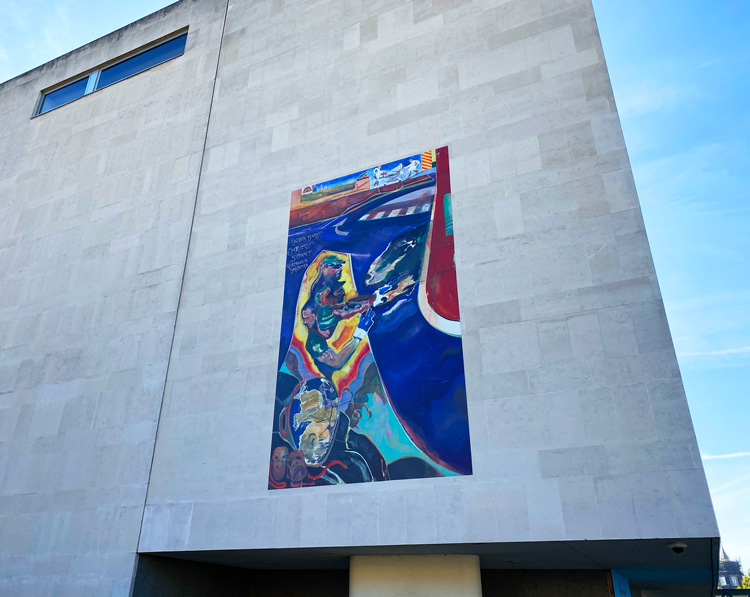
Michael Armitage. John Barry, O Kelly, Sonny and Richard Moore, 2020. Installation view, Everyday Heroes, Southbank Centre, London, 2020. Photo: Martin Kennedy.
Normally, my work takes a long time to make. I work on a series of paintings for about two years and usually I will have been thinking about the ideas for a couple of years before that. I’m almost certain there will be images, paintings, affected by this time.
JR: Your work spans the UK and Kenya, Europe and Africa. Where is “home”?
MA: Kenya feels like home, even though I’ve been in London for 20 years.
JR: Growing up in Kenya, what were your first experiences of art? Were your family artistic?
MA: My father, who is from Huddersfield, is an accountant and not artistic at all. My mother was creative, in that she did fashion and had an interior design company in Nairobi for many years, but she was never into art. My family didn’t go to exhibitions. The first museum I visited was when I was on my foundation year in London.
I just loved drawing and I had a great art teacher at school. I used to spend every weekend at his house and he’d leave me for hours drawing and painting. At that stage, I didn’t really know what an artist was, I just knew I enjoyed making stuff. Then my closest friend’s mother was an artist, Chelenge van Rampelberg – one of her sculptures (Eve) is in the RA exhibition, and she was the first female sculptor from Kenya. She introduced me to artists and exhibitions and I got to watch her as an artist making sculpture and painting and see what that was like.
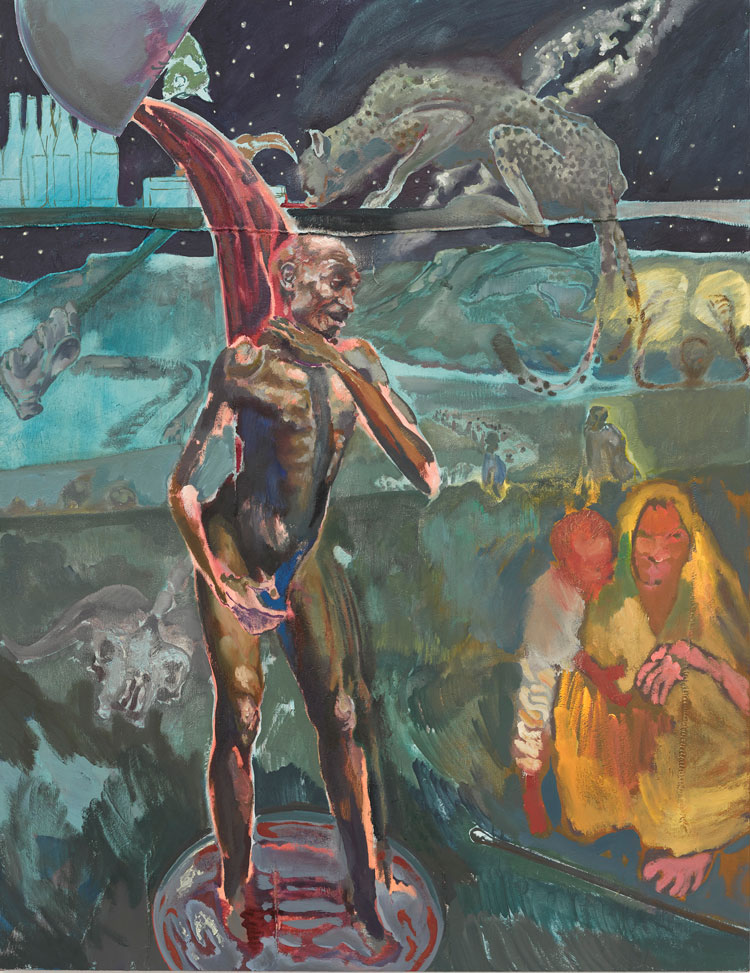
Michael Armitage, Mydas, 2019. Oil on Lubugo bark cloth, 220 x 170 cm. Courtesy of the Artist and White Cube © Michael Armitage. Photo: © White Cube (Theo Christelis).
Until my interest, art didn’t feature in my family, but six months ago my father told me that, when he was studying to be an accountant, he’d take breaks by going to look at a Paul Cézanne book in the library. He even had a poster of a Cézanne landscape on his wall and a photo of Cézanne himself. It’s really bizarre because Cézanne has been such an important artist for me and I looked at him for years without knowing this. I had never heard my father say anything about art before – ever! – and I just thought, wow.
JR: So your primary introduction to art was East African art rather than the western canon?
MA: Yes. I hadn’t seen any western art in the flesh until I was on my foundation course in London. All I knew was from books. The work I grew up around was very much the East African art scene, like the works in the RA exhibition. It was those guys who made me want to do this. Their work and them as artists, as characters. I loved that they were different from anyone else I would meet and seemed much more open and interested in things in life. As a kid, I found it exciting – it was something I gravitated towards.
JR: What drew you specifically to painting as your medium?
MA: It is just what I was doing. Although when I would spend hours in Chelenge’s studio, she’d always give me a little piece of wood and a chisel and a hammer. I would like to do that [sculpture] at some point, but I still have a long way to go with painting. It demands a lot and, although it can be frustrating and demoralising at times, I get so much out of painting. I have questioned [my medium] in the past, but painting is something I’ve been doing since I was six and it’s part of who I am.
JR: When you arrived in London to train, did you find a very different approach to art from what you had been used to in Kenya?
MA: Very different. But that wasn’t unexpected. I was in a different country, thousands of miles away from where I grew up. I didn’t expect people here to know about where I was from because I really didn’t know anything about here. Maybe I know a little bit more now, but I’ve always felt I have a lot of catching up to do in terms of contemporary art and the history of art because it is not something I grew up around. I would be a very inconsistent narrator of the history of art, but I spend a lot of time looking at, and thinking about, the things that I love and feel affected by.
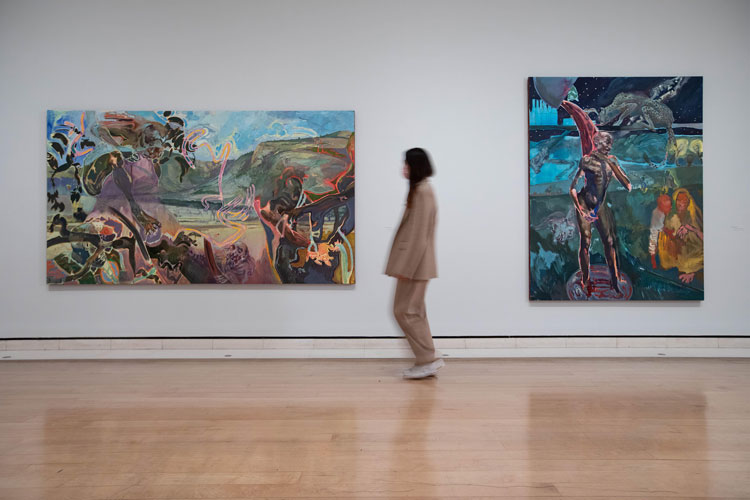
Michael Armitage, Enasoit, 2019, and Mydas, 2019, installation view, Michael Armitage: Paradise Edict, 22 May – 19 September 2021, Royal Academy of Arts, London. Loans courtesy the artist and White Cube © Michael Armitage. Photo: David Parry / © Royal Academy of Arts.
JR: I think it is self-evident to the viewer, but do you feel that you have had additional richness in having both those artistic legacies to draw on?
MA: I think what is most important is that I’ve never felt a sense of hierarchy. I think it’s very easy within the history of art to feel a cultural hierarchy, and not having that is liberating. To take artists and work at face value – and learn about it afterwards – leaves a lot of space to be affected by things. I appreciate not having grown up being told: “These are the greatest things ever made and these are the greatest people who ever made them.”
JR: Perhaps not having an artistic family and discovering it all yourself can be an advantage?
MA: Yes, it’s made it an incredibly exciting journey because, every time I come across something, it feels like a discovery, and it means that I still have so much I haven’t seen, haven’t come across, and that’s very exciting.
JR: You make a lot of visual reference to both East African and western old masters’ painting. Do viewers need to pick up these references to understand your paintings, or is a subconscious impact enough? I’m thinking, for instance, of the altarpiece-like composition of Pathos and the Twilight of the Idle. Do viewers need to know it is drawn from the composition of Titian’s The Assumption of the Virgin to understand the work?
MA: I don’t think my paintings have a particular meaning, so there isn’t anything specific to to understand. Obviously, everything is made within a context, but that doesn’t mean it can’t have an effect without knowing all the history that has led to that point. Meaning is brought by whoever stands in front of it. I hope the references may enrich the time spent with the paintings, but mostly they are there to help me as an artist to think through stuff.
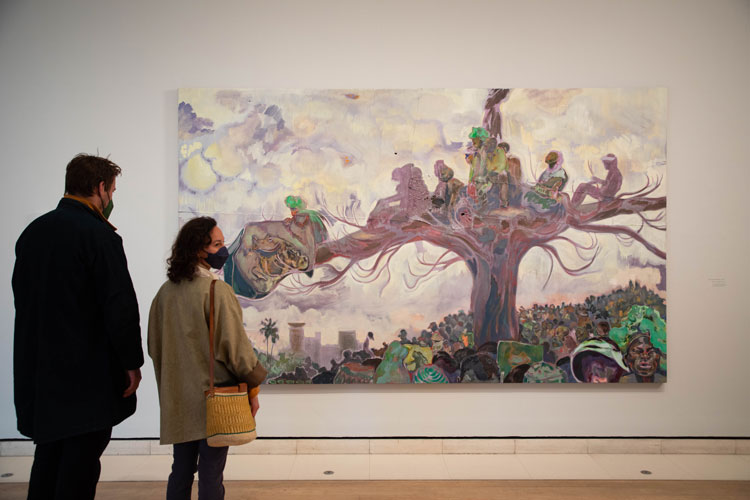
Michael Armitage, The Fourth Estate, 2017, installation view, Michael Armitage: Paradise Edict, 22 May – 19 September 2021, Royal Academy of Arts, London.. On loan from The Joyner/Giuffrida Collection © Michael Armitage. Photo: David Parry / © Royal Academy of Arts.
JR: Your pictures do have a huge amount in them. Do you hope people will spend time in front of them?
MA: On this one, my vanity gets the better of me and I really do hope people will spend time! I would love the paintings to mean something to other people as well as to myself and for people to spend time with them.
JR: Your work is quite political, but never in a propagandist way. Would it be fair to say that you are interested in throwing light on something and questioning rather than in activism and offering particular solutions?
MA: Yes. I would feel very dubious of myself if I felt that I had answers to provide to people.
JR: The title of the RA exhibition, Paradise Edict, and a significant proportion of the work, arose out of the 2017 Kenyan general election. Can you tell me a bit about how that came about?
MA: It began with wanting to make work about power relationships and as I was going back to Kenya to vote, I thought a way to begin would be to go to one of the rallies. What I thought would lead to one work led to two years of work. There were so many things that I hadn’t anticipated about the experience, about the relationships between people, the fervour and intensity, and also the performance of it – from the supporters as well as from the leaders and politicians.
I didn’t take many photos or videos – I wanted to absorb the atmosphere and really feel it as opposed to looking for interesting things – but I went with some journalists and they sent me video and photographs of that rally and other rallies. There were certain things that began to stand out, like the people who were visually bizarre, dressed up as superheroes or in clown outfits, who appeared at every rally. And when the rallies turned violent, they were the guys on the frontline throwing stones at the police and being shot at and running through tear gas.
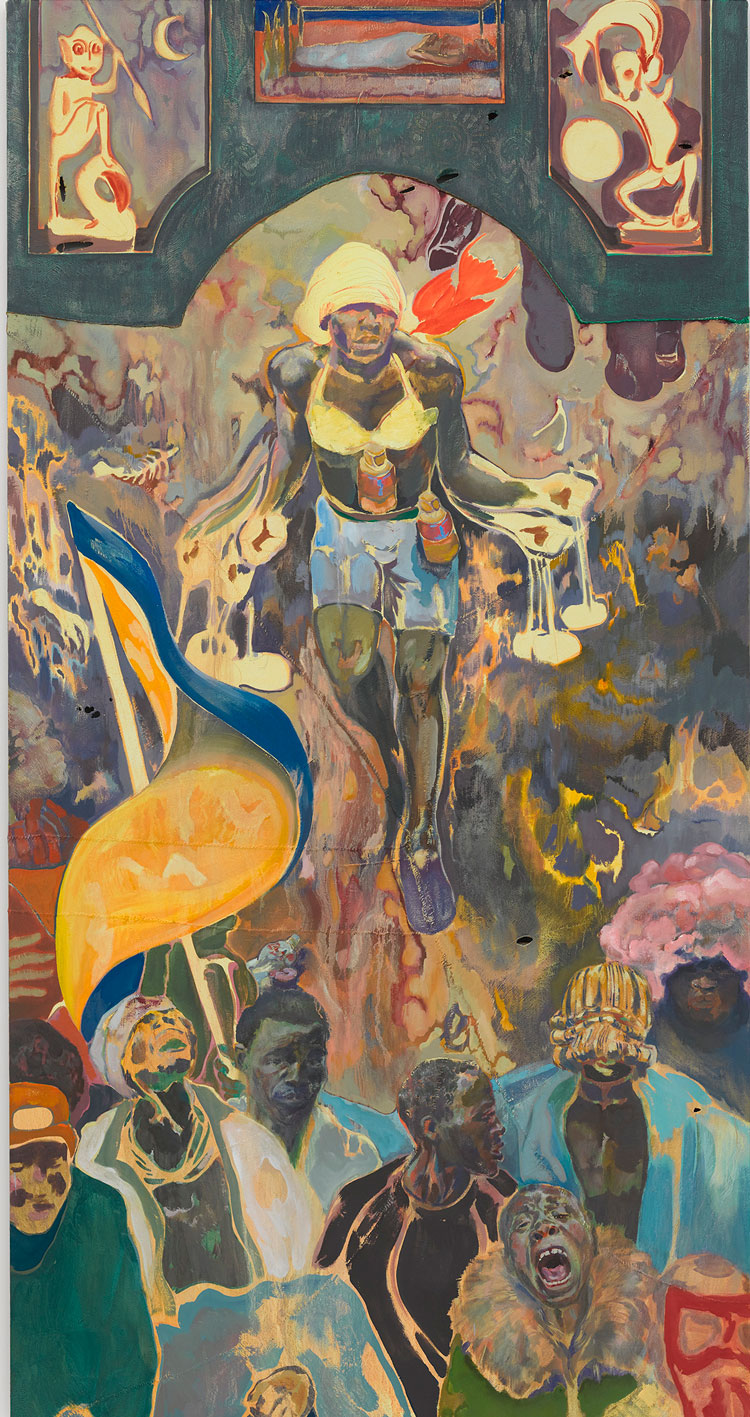
Michael Armitage, Pathos and the twilight of the idle, 2019. Oil on Lubugo bark cloth, 330 x 170 cm. Courtesy of the Artist and White Cube © Michael Armitage. Photo: © White Cube (Theo Christelis).
JR: That is presumably where the central figure in Pathos and the Twilight of the Idlecomes from?
MA: Exactly. All the figures come from documentary images.
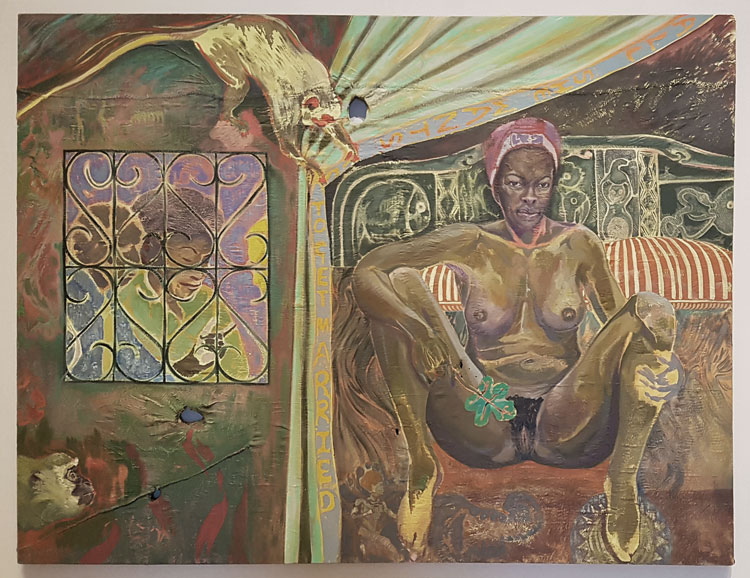
Michael Armitage, Antigone, 2018. Oil on Lubugo bark cloth, 170 × 220 cm. Installation view. Photo: Juliet Rix.
JR: Tell me about Antigone? It’s such a striking painting – the figure with her very direct gaze, the fig leaf that isn’t covering her exposed genitals, the banner saying: “All she wants is to get married.” There is so much going on in that picture.
MR: It came out of the election series. I was thinking about this idea of being led to Canaan and then I was thinking about what the pressures are in society that are meant to lead you to something hopeful or to happiness, and I wanted to do a male and female version of that. Marriage is set up as providing a place within society for women that they wouldn’t have if they weren’t married, which is the case in some communities at home. I wanted to think about that and question that, and I’d been reading the story of Oedipus. Antigone is an extraordinary figure in that she rebels by turning down a marriage that was supposed to quell her and there are significant consequences to her choices. That was interesting to me as a metaphor for the consequences that women would have to face at home [in Kenya] as well. Then I’d also come across this painting by Jak Katarikawe, She Is Dream(ing) of Wedding, which is in the RA show, and that gave me the pose that Antigone took.
JR: And the red-lipsticked chameleon? You use animals quite a bit – a toad in the election paintings, many different monkeys – and sometimes they are quite symbolic.
MA: No one has noticed that! I don’t think anyone has told me before that they’ve seen the chameleon. Yes, I use animals. Sometimes they are just animals, but, for sure, their significance shifts depending on the context. They certainly play a big part in my painting and they’re part of the art I grew up with. Animals were often used in East African art.
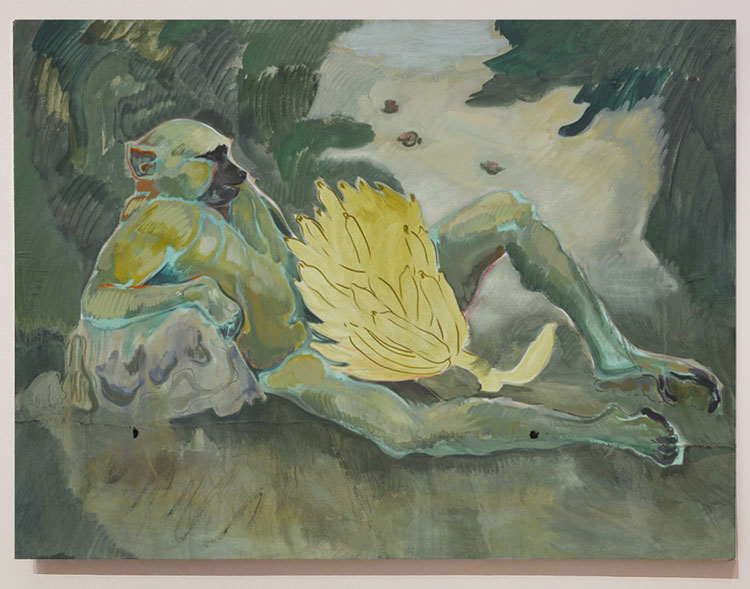
Michael Armitage, Baboon, 2016. Oil on Lubugo bark cloth, 150 x 200 cm. Installation view. Photo: Juliet Rix.
JR: Looking at Baboon (2016) [a baboon lounging on its back with a huge bunch of bananas balanced on its groin], I did wonder whether you thought that, if you were not of black African heritage, this image might be misread?
MA: It has been misread! If somebody sees it that way, that’s not my Baboon, that’s their Baboon. I can’t take responsibility for everyone’s thoughts.
JR: What are your plans for the future? What’s next?
MA: I’m opening a show in a couple of weeks in Copenhagen, Account of an Illiterate Man, then I have a series of group shows, and I’m working towards a solo show next year. At the NCAI, we’ll be opening a solo show of Sane Wadu, then the Mwili, Akili Na Roho room, when it finishes at the RA, will form part of a bigger exhibition, in our space in Nairobi.
JR: That sounds like a very busy couple years. I think I see why the lockdowns were a useful time to just paint.
MR: The painting is what I enjoy. The annoying thing is having a telephone (it’s ringing). It’s making time for everything else that’s hard; I will always make the time to paint.
• Michael Armitage: Paradise EdictParadise Edict is at the Royal Academy, London, until 19 September 2021. Account of an Illiterate Man is at Glyptoteket, Copenhagen, until 17 October 2021.